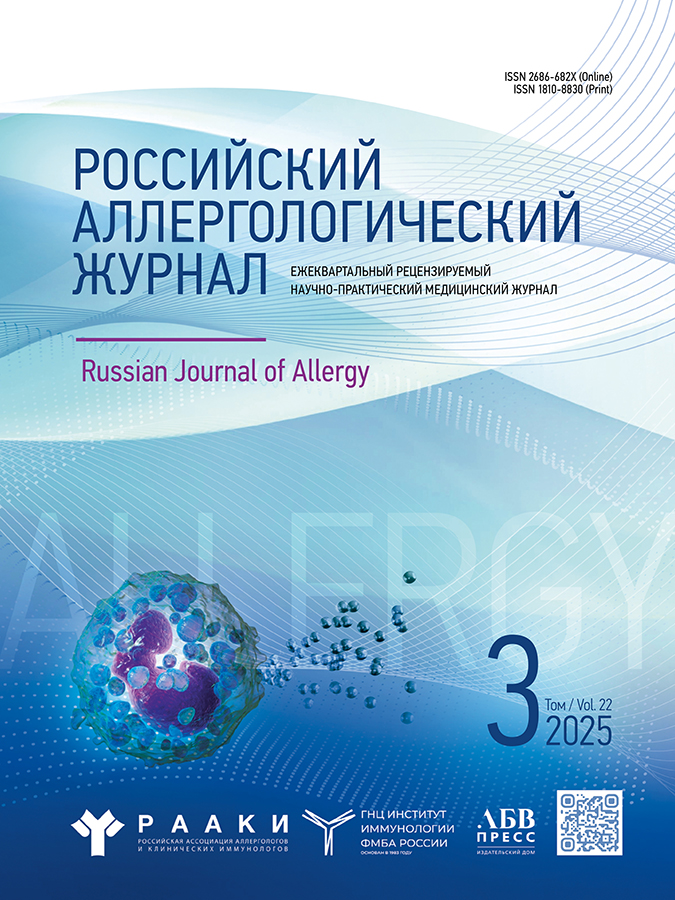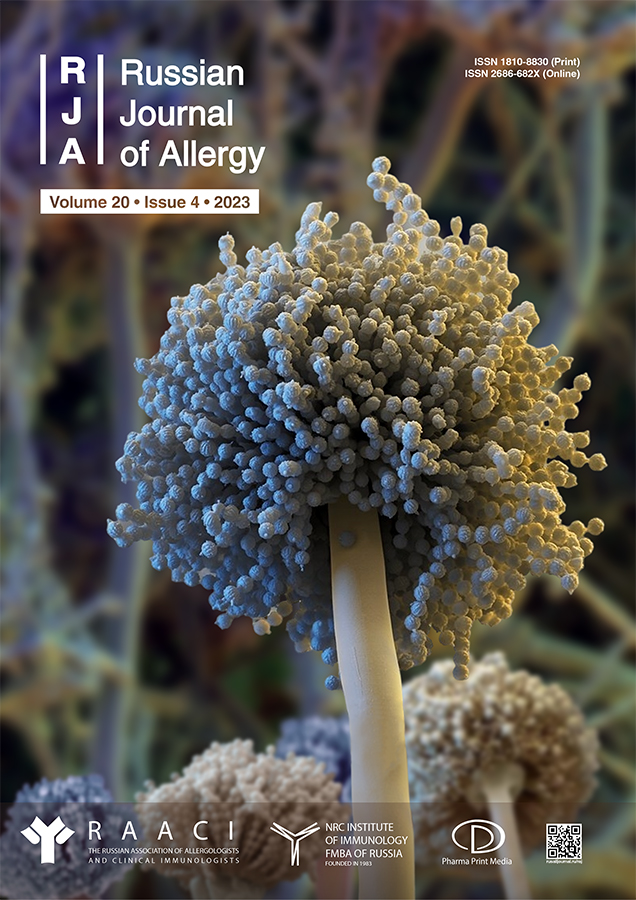Clinical predictors of antihistamine resistance in patients with chronic spontaneous urticaria
- Authors: Popova C.Y.1, Zaborova V.A.1, Kurshev V.V.1, Kovalkova E.V.2, Serdotetskova S.A.2, Fomina D.S.1,2, Borzova E.Y.1
-
Affiliations:
- The First Sechenov Moscow State Medical University (Sechenov University)
- Moscow City Hospital 52, Moscow City Scientific and Practical Centre of Allergology and Immunology
- Issue: Vol 20, No 4 (2023)
- Pages: 402-414
- Section: Original studies
- Submitted: 29.04.2023
- Accepted: 28.11.2023
- Published: 02.12.2023
- URL: https://rusalljournal.ru/raj/article/view/7951
- DOI: https://doi.org/10.36691/RJA7951
- ID: 7951
Cite item
Abstract
BACKGROUND: Сhronic spontaneous urticaria is characterized by itchy wheals and/or angioedema on the skin for ≥6 weeks. A large-scale international AWARE study by Russian researchers indicated the ineffectiveness of therapy with standard doses of second-generation antihistamines in >50% of patients with chronic spontaneous urticaria. Clinical predictors of antihistamine resistance include low quality of life based on CU-Q2oL, baseline urticaria activity score for 7 days (UAS7) >16, combination with chronic inducible urticaria, and autoimmune comorbidity. Currently, research into the clinical predictors of antihistamine resistance, including body mass index, in patients with chronic spontaneous urticaria is ongoing.
AIM: To examine the degree of symptom control based on body mass index and physical activity in patients with chronic spontaneous urticaria treated with second-generation antihistamines.
MATERIALS AND METHODS: The examination of patients with сhronic spontaneous urticaria (n=34) included the clinical history and use of the following international questionnaires: UAS7, urticaria control test, dermatology quality of life index, and global physical activity questionnaire of the World Health Organization. The questionnaires were analyzed in subgroups of patients with controlled and uncontrolled chronic spontaneous urticaria and subgroups of patients with chronic spontaneous urticaria having normal weight, overweight, and obesity.
RESULTS: Uncontrolled symptoms were observed in 24 (70.6%) patients with chronic spontaneous urticaria, including 11 (45.8%) with resistance to fourfold doses of second-generation antihistamines. In 52.9% of patients with chronic spontaneous urticaria, the body mass index exceeded normal values. In this study, an inverse correlation was found between the body mass index and the degree of control of chronic spontaneous urticaria symptoms.
CONCLUSIONS: Owing to the negative correlation between body mass index and the degree of symptom control, further research into the role of body mass index as a clinical predictor of antihistamine-resistant chronic spontaneous urticaria is needed. In the future, personalized therapy for chronic spontaneous urticaria may consider the degree of disease control, clinical predictors of antihistamine resistance, and proinflammatory biomarkers.
Full Text
About the authors
Christina Yu. Popova
The First Sechenov Moscow State Medical University (Sechenov University)
Email: popova.derm@gmail.com
ORCID iD: 0000-0002-7855-6207
SPIN-code: 5794-9317
MD
Россия, MoscowVictoria A. Zaborova
The First Sechenov Moscow State Medical University (Sechenov University)
Email: vaz111v@gmail.com
ORCID iD: 0000-0001-5044-1152
SPIN-code: 5969-8486
MD, Dr. Sci. (Med.), Professor
Россия, MoscowVladislav V. Kurshev
The First Sechenov Moscow State Medical University (Sechenov University)
Email: kurshevvlad@gmail.com
ORCID iD: 0000-0002-1729-0513
SPIN-code: 2766-3925
MD, Cand. Sci. (Med.)
Россия, MoscowElena V. Kovalkova
Moscow City Hospital 52, Moscow City Scientific and Practical Centre of Allergology and Immunology
Email: kovalkova@ya.ru
ORCID iD: 0000-0002-1212-3767
SPIN-code: 3078-0976
Россия, Moscow
Sofia A. Serdotetskova
Moscow City Hospital 52, Moscow City Scientific and Practical Centre of Allergology and Immunology
Email: darklynx813@gmail.com
ORCID iD: 0000-0001-8472-1152
SPIN-code: 6644-6715
Россия, Moscow
Daria S. Fomina
The First Sechenov Moscow State Medical University (Sechenov University); Moscow City Hospital 52, Moscow City Scientific and Practical Centre of Allergology and Immunology
Email: daria_fomina@mail.ru
ORCID iD: 0000-0002-5083-6637
SPIN-code: 3023-4538
Россия, Moscow; Moscow
Elena Yu. Borzova
The First Sechenov Moscow State Medical University (Sechenov University)
Author for correspondence.
Email: eborzova@gmail.com
ORCID iD: 0000-0003-1587-9137
SPIN-code: 4779-7664
MD, Dr. Sci. (Med.), Professor
Россия, MoscowReferences
- Zuberbier T, Abdul Latiff AH, Abuzakouk M, et al. The international EAACI/GA²LEN/EuroGuiDerm/APAAACI guideline for the definition, classification, diagnosis, and management of urticaria. Allergy. 2022;77(3):734–766. doi: 10.1111/all.15090
- Allergology. Federal clinical recommendations. Ed. by R.M. Khaitov, N.I. Ilyina. Moscow: Pharmarus Print Media; 2014. 126 р. (In Russ).
- Moestrup K, Ghazanfar MN, Thomsen SF. Patient-reported outcomes (PROs) in chronic urticaria. Int J Dermatol. 2017;56(12):1342–1348. doi: 10.1111/ijd.13668
- Maurer M, Weller K, Bindslev-Jensen C, et al. Unmet clinical needs in chronic spontaneous urticaria. A GA²LEN task force report. Allergy. 2011;66(3):317–330. doi: 10.1111/j.1398-9995.2010.02496.x
- Gonçalo M, Gimenéz-Arnau A, Al-Ahmad M, et al. The global burden of chronic urticaria for the patient and society. Br J Dermatol. 2021;184(2):226–236. doi: 10.1111/bjd.19561
- Weldon DR. Quality of life in patients with urticaria. Allergy Asthma Proc. 2006;27(2):96–99.
- O'Donnell BF, Lawlor F, Simpson J, et al. The impact of chronic urticaria on the quality of life. Br J Dermatol. 1997;136(2):197–201.
- Zuberbier T, Aberer W, Asero R, et al. The EAACI/GA²LEN/EDF/WAO guideline for the definition, classification, diagnosis and management of urticaria. Allergy. 2018;73(7):1393–1414. doi: 10.1111/all.13397
- Grob J, Auquier P, Dreyfus I, Ortonne J. How to prescribe antihistamines for chronic idiopathic urticaria: Desloratadine daily vs PRN and quality of life. Allergy. 2009;(64):605–612. doi: 10.1111/j.1398-9995.2008.01913.x
- Maurer M, Costa C, Gimenez Arnau A, et al. Antihistamine-resistant chronic spontaneous urticaria remains undertreated: 2-year data from the AWARE study. Clin Exp Allergy. 2020;50(10):1166–1175. doi: 10.1111/cea.13716
- Guillen-Aguinaga S, Jauregui Presa I, Aguinaga-Ontoso E, et al. Updosing nonsedating antihistamines in patients with chronic spontaneous urticaria: A systematic review and meta-analysis. Br J Dermatol. 2016;175(6):1153–1165. doi: 10.1111/bjd.14768
- Wang L, Ke X, Kavati A, et al. Real-world treatment patterns and outcomes of omalizumab use in patients with chronic idiopathic urticaria. Curr Med Res Opin. 2018;34(1):35–39. doi: 10.1080/03007995.2017.1395732
- Zhao ZT, Ji CM, Yu WJ, et al. Omalizumab for the treatment of chronic spontaneous urticaria: A meta-analysis of randomized clinical trials. J Allergy Clin Immunol. 2016;137(6):1742–1750.e4. doi: 10.1016/j.jaci.2015.12.1342
- Tharp MD, Bernstein JA, Kavati A, et al. Benefits and harms of omalizumab treatment in adolescent and adult patients with chronic idiopathic (spontaneous) urticaria: A meta-analysis of "real-world" evidence. JAMA Dermatol. 2019;155(1):29–38. doi: 10.1001/jamadermatol.2018.3447
- Fok JS, Kolkhir P, Church MK, Maurer M. Predictors of treatment response in chronic spontaneous urticaria. Allergy. 2021;76(10):2965–2981. doi: 10.1111/all.14757
- Curto-Barredo L, Archilla LR, Vives GR, et al. Clinical features of chronic spontaneous urticaria that predict disease prognosis and refractoriness to standard treatment. Acta Derm Venereol. 2018;98(7):641–647. doi: 10.2340/00015555-2941
- Maurer M, Staubach P, Raap U, et al. H1-antihistamine-refractory chronic spontaneous urticaria: It's worse than we thought: First results of the multicenter real-life AWARE study. Clin Exp Allergy. 2017;47(5):684–692. doi: 10.1111/cea.12900
- Trinh HK, Pham DL, Ban GY, et al. Altered systemic adipokines in patients with chronic urticaria. Int Arch Allergy Immunol. 2016;171(2):102–110. doi: 10.1159/000452626
- Kolkhir P, Pogorelov D, Olisova O. CRP, D-dimer, fibrinogen and ESR as predictive markers of response to standard doses of levocetirizine in patients with chronic spontaneous urticaria. Eur Ann Allergy Clin Immunol. 2017;49(4):189–192. doi: 10.23822/eurannaci.1764-1489.05
- Sánchez Borges M, Tassinari S, Flores A. [Epidemiologic features in patients with antihistamine-resistant chronic urticaria. (In Spanish)]. Rev Alerg Mex. 2015;62(4):279–286.
- Danilycheva I, Emelyanov A, Meshkova R, et al. Treating chronic urticaria refractory to H1-antihistamines in Russia: Data from the AWARE study. Postepy Dermatol Alergol. 2022;39(3):509–516. doi: 10.5114/ada.2022.117556
- Ye YM, Jin HJ, Hwang EK, et al. Co-existence of chronic urticaria and metabolic syndrome: Clinical implications. Acta Derm Venereol. 2013;93(2):156–160. doi: 10.2340/00015555-1443
- Zbiciak-Nylec M, Wcisło-Dziadecka D, Kasprzyk M, et al. Overweight and obesity may play a role in the pathogenesis of chronic spontaneous urticaria. Clin Exp Dermatol. 2018;43(5):525–528. doi: 10.1111/ced.13368
- Lapi F, Cassano N, Pegoraro V, et al. Epidemiology of chronic spontaneous urticaria: Results from a nationwide, population-based study in Italy. Br J Dermatol. 2016;174(5):996–1004. doi: 10.1111/bjd.14470
- Soria A, Du-Thanh A, Amsler E, et al.; French urticaria group (GUS) of French dermatological society. Obesity is not associated with severe chronic urticaria in a French cohort. J Eur Acad Dermatol Venereol. 2018;32(6):e247–e249. doi: 10.1111/jdv.14767
- Devaraj S, Rosenson RS, Jialal I. Metabolic syndrome: An appraisal of the pro-inflammatory and procoagulant status. Endocrinol Metab Clin North Am. 2004;33(2):431–453. doi: 10.1016/j.ecl.2004.03.008
- Neiman M, Hellström C, Just D, et al. Individual and stable autoantibody repertoires in healthy individuals. Autoimmunity. 2019;52(1):1–11. doi: 10.1080/08916934.2019.1581774
- Tsigalou C, Vallianou N, Dalamaga M. Autoantibody production in obesity: Is there evidence for a link between obesity and autoimmunity? Curr Obes Rep. 2020;9(3):245–254. doi: 10.1007/s13679-020-00397-8
- Asero R, Cugno M. Biomarkers of chronic spontaneous urticaria and their clinical implications. Expert Rev Clin Immunol. 2021;17(3):247–254. doi: 10.1080/1744666X.2021.1882304
- Fang X, Li M, He C, et al. Plasma-Derived exosomes in chronic spontaneous urticaria induce the production of mediators by human mast cells. J Invest Dermatol. 2022;142(11):2998–3008.e5. doi: 10.1016/j.jid.2022.03.037
- Razina AO, Runenko SD, Achkasov EE. Obesity: Current global and Russian trends. Annals Russ Academ Med Scis. 2016;71(2):154–159. (In Russ). doi: 10.15690/vramn655
Supplementary files










